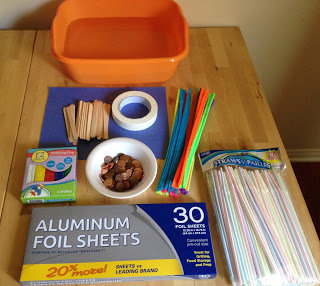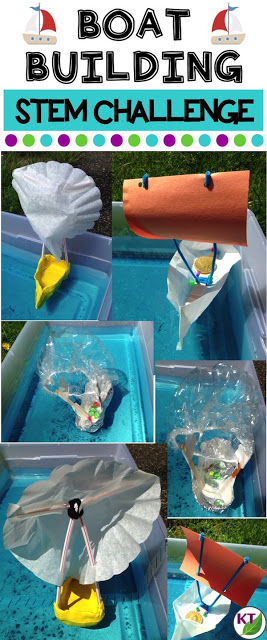PIN ME
Video Transcription
Hi, there. Welcome to the very best day of the week, STEM Challenge Day. The last time, I told you we were all done with the summer STEM challenges, and it turns out that was not entirely true. I didn’t mean to lie to you. It’s just that I think of the Build a Boat Challenge as an anytime challenge, but of course it’s great for summer. You might recall back in November; we did a boat challenge called Mini Mayflower. You might be wondering if this is really any different, and the answer is yes, I have a lot of new ideas for you. Mini Mayflower is basically a holiday-themed smaller subset of this challenge, so today I’m going to be giving you some new ideas. I’m going to assume you’re already familiar with the Mini Mayflower challenge, so if you’re not, you might want to pause this. Go ahead and watch the Mini Mayflower video and come right on back. I’ll link that down in the description below. There are basically three categories that you can adjust and shift to make this boat-building challenge an entirely new experience for your students.
0:52 About Boat Challenges
Now, if you’ve already done a capacity boat challenge with your students, the most obvious thing to do differently here would be to focus on sailboats and have the students design boats built for speed. If you’ve already done a capacity and boat speed challenge with your students, don’t worry. I’m going to give you some new ideas you can use today. Since the other video focused on capacity, today I’m going to be focusing on the sailing challenges. Now, if you’re doing a sailing challenge, you’re going to need a larger container, so if you have a stream table, that’s great. Another idea is to use under-the-bed storage bins or kiddie pools, and, of course, you’re going to want to get those in place before you fill them up with water. Figured that one out the hard way myself. A straight sailing test would just be to time the boat from the start to the finish line. Well, let’s say you’ve been there and done that, and you want to try something different.
1:35 Boat Challenge Examples & Ideas
One idea is to focus on the relationship between mass and inertia, so you can tape just with masking tape a line in the bin before you fill it with water and have the students power the boat up until that point, and they stop. Then they see how much the boat drifts on its own past that point, and they measure that off. If you’re going to do that test, you’re going to need a scale so that students can determine the mass or at least the weight of their boat. One idea I love to shake this challenge up is to create an obstacle course within the sailing container, so what you can do is just drop some bottles or some vases in, and the boats can either need to sail through them or around them, or you can even create ports where the boats have to sail up to them and touch, and then they either need to load cargo or unload cargo before proceeding to the next port. In terms of measuring results, you can do it one of two ways.
2:24 Making the Competition Fun
You could either measure how much time it takes the boats to complete whatever the obstacle course is, and the other way to do it is to give students a set amount of time to collect as much cargo from the ports as possible, so they would touch one bottle. They would collect one piece of cargo, proceed to the next one, collect one piece of cargo, and they could go back and forth to as many different ports as there are and collect as much as they can within the allotted timeframe. Another idea is something I call capture the flag, though it doesn’t really need to be a flag. Over the sailing container, you can rig up just a piece of string, or you can even have two students hold either end of the string. Have something dangling, maybe even just a pipe cleaner formed into a circle, loosely over the string, and task students with designing a boat that can sail past and capture one or more rings.
3:13 Choosing Materials for Boats
Another way to make this boat challenge very different from one you may have already done is to think about the materials you provided and change them pretty dramatically. So if the students all used foil sheets in their first iteration, don’t provide foil this time. Try using wax paper or clay, or even some other kind of paper, or whatever you can think of. Each of these materials comes with its advantages and disadvantages, so a design that works well with one doesn’t always translate well to another. Just a quick note on materials. They are always suggested places to start. You can always add in other ideas, and you should, and you’ll see here some ideas that were not in the picture. The wax paper, that’s a shower cap down there, and I didn’t have the types of cargo that you’re going to see here today.
3:58 Weighted Materials Like Pennies or Marbles
Even if you’re not planning to do a capacity test, you’re only going to do sailboat speed, you want to make sure you still have some marbles or some pennies, some kind of weighted materials available, because some students will find, when they put their boat in the water, that it’s sort of off-balance, but they can fix it by adding weights in certain points of the boat. Assuming you’re doing this challenge outside, you’re going to want to pay attention to the direction the wind is blowing so that the students aren’t working against the wind. Now, you can let the students power the boats. You can let the wind do it naturally, or you could even bring in a small fan. Even if you choose to use a fan or natural wind, I would still always give students an option to have either a straw or a balloon, some way that they can get their boats unstuck without actually touching them, because I usually put that in the constraints list, that they’re not allowed to touch them physically once they’re in the water.
4:47 Additional Materials and Considerations
It’s also nice if you have smaller plastic containers, maybe shoebox size, to let students have with their group, so that they can give their boats a balance test before they get out and do the main test. One thing to think about if the students are powering their boats with their own wind power is to make sure that each team has an equal number of students who are allowed to participate in powering the boat to sort of even the playing field. And the final idea to make this challenge unique against all other boat challenges is to focus on what you do in the extension activities. I recommend a deeper, class-wide data analysis activity. You could have students graph different types of results. Older students could calculate speed, and design their own experiments where they use the scientific method to figure out what changes can they make to impact the speed of sailboats. You have all the basics to conduct boat-building in your class on your own, but this resource just got a crazy update, complete overhaul. Take a second to check it out. It’s going to save you so much time.
5:45 Printable or Paperless Resource with Everything You Need + Teacher Guide
This time-saving resource contains everything you need, including modifications for use with second through eighth-graders. You’ll still need to gather the simple materials, of course, but the rest is ready and waiting. You’ll get Aligned Next Generation Science Standards, links to my STEM Challenge How-to videos to help you get the most from each challenge, and the Boat-Building Materials list. In Teacher Tips, you’ll find premise and setup, how to increase or decrease difficulty through the Criteria and Constraints list, measuring results, and cross-curricular extension suggestions. You’ll find two editable Criteria and Constraints lists so you can tailor the challenge to your students. For student design analysis handouts, there are two versions. Five-page expanded room for response for younger students, and a three-page condensed space paper-saver version. You’ll get one set for a capacity challenge and a second for capacity and/or speed. You’ll also find a set of group discussion questions. In the Extension Handouts, you’ll find a class-wide data analysis activity, graphing templates, a design-your-own-experiment activity, and calculating boat speed handouts, as well as additional math extension, design, report, and process flow templates.
You’ll also receive a detailed Teacher Guide and everything that comes with the holiday version of the boat building challenge, Mini Mayflower. This resource is available individually and is part of the discounted Mega STEM Challenge Bundle. Links can be found in the description below the video. So much goodness, right? Make sure you’re following my store and Teachers Pay Teachers, and subscribed on YouTube so you don’t miss anything. I hope you and your students have a fantastic time building your boats. Have a great week. I’ll see you next time.







